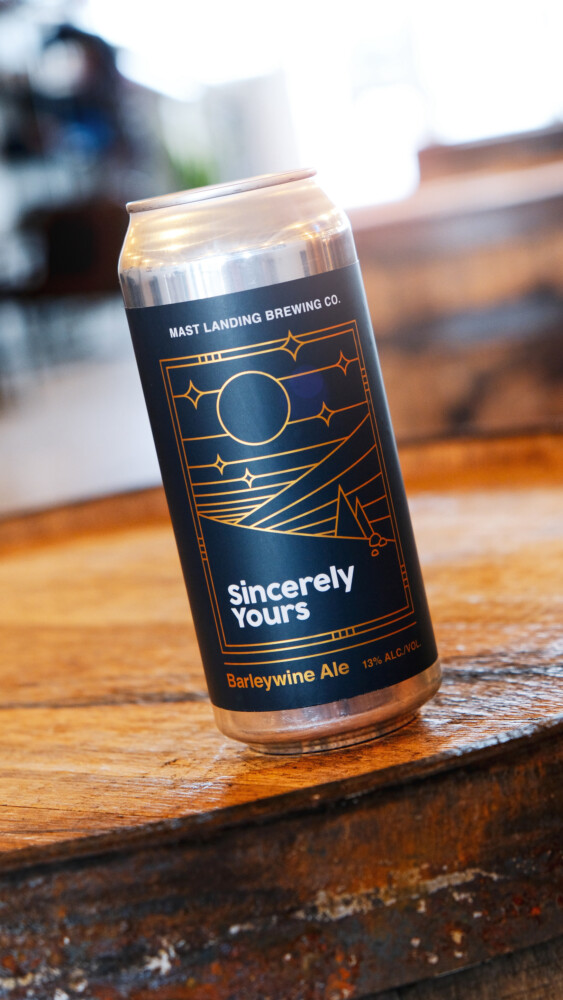Barleywine. It’s a pretentious sounding beer with aristocratic origins and a transnational history. But ironically, it is perhaps best enjoyed in the most plebeian and local settings – at home, in pajamas, on one’s couch.
Mast Landing recently released its first barleywine, Sincerely Yours. It’s new to us, but it’s older than most beers we drink, having sojourned in bourbon barrels for 17 months (17!) before canning. At 13% ABV, it is a bear, though about as cuddly as they come. Opaque and ruby brown, it smells like cherry liqueur chocolates. It has a deliciously chewy body and smooth texture. Sticky toffee pudding. Dark and dried fruit. Tawny port and a trace of oaky bourbon. A late wave of chocolate, accompanied by a boozy hug.
The beer shapeshifts as it warms up, unfurling its layers. It might seem like faint praise to say this is my favorite beer of the new year, but there’s little doubt I’ll still be thinking about it in 11 months’ time. (And if I had any discipline, I’d be drinking it then as well, having stashed some in the cellar for next winter. But I know myself too well.)
In designing the beer, the brewers didn’t want to overcomplicate things. Rather, “we let the malt and the aging process work their magic,” Mast Landing Production Manager Weston Shepherd explained. Much of the complex layering of flavors derives from the aging process. Putting the beer in wood enables some oxidation, because of the barrel’s porousness.
“Oxidation is generally the enemy of beer,” Shepherd said. “However, with the right base beer and the right amount of aging time in a barrel, it can really cause some fantastic flavors and aromas that aren’t replicable any other way.”
But this also amplifies the risk and challenge of making a barrel-aged barleywine. It takes more time, and brewers have to be patient and hopeful that the beer doesn’t get infected. Even then, as Shepherd said, “it’s hard to know if the beer is coming along as intended.”
Brewers must be prepared to dump batches that don’t turn out right – a costly possibility. And they must also embrace contingency: “Even if we brewed the same beer the same way, the aging process wouldn’t produce the exact same result,” according to Shepherd. It is a costly endeavor, with high risks and rewards.
If this sounds quite decadent, well, that aligns with its history. The first barleywines were made in the breweries affiliated with England’s great aristocratic houses, to be drunk by the wealthy. They would often be aged in wood barrels for a year or even longer. These strong beers were intended to pinch hit for actual wine, at a time when supplies from the European mainland could be uneven. They also had a depth and complexity to them that many perceived as wine-like.
But barleywine wasn’t considered commercially viable until the mid-19th century, when the brewers Bass, Ratcliff & Gretton, from Burton upon Trent, developed the gloriously named “No. 1.” It was just the second trademark registered in Britain (the first was the brewery’s logo). It would be brewed almost continuously until 1995, when it was discontinued.
By then, American craft brewers had picked up the style and reinterpreted it, beginning with Anchor Brewing’s Old Foghorn (debuted in 1975) and Sierra Nevada Brewing’s Bigfoot (1983). These American barleywines would be distinguished from the English tradition by their assertive bitterness, amplified by so-called New World hops typically associated with West Coast IPAs, like Cascade, Centennial and Chinook.
Those beers would become seasonal staples, and so too has Austin Street’s Snowblower, a 10% American-style barleywine (that isn’t barrel-aged). Amber-brown in the glass, its citrusy nose announces its hoppy makeup. Malty with moderate carbonation, it finishes bitter and dry. Tasted alongside the rich sweetness of Mast Landing’s Sincerely Yours, one gets a sense of the style’s range.

The flavors of Barreled Souls’ Bourbon Blonde on Blonde evolve as you sip it. Photo courtesy of Barreled Souls
In the historical geography of barleywine, Maine is almost exactly halfway between Britain’s West Midlands and the Pacific Northwest. Sebago Brewing’s precisely named “Barleywine” reflects a fusion of the American and English styles; as the brewery notes, “Our barleywine ale is a blend of old world influence and modern day ingredients.” This year’s version weighs in at a hefty 13.75% ABV. Unlike some previous iterations, this one steers away from fruitiness and squarely into a massive chocolate-toffee flavor, accented with bourbon from 10 months of barrel-aging. It also possesses a moderate bitterness, tempering the boozy sweetness.
Barreled Souls’ Bourbon Blonde on Blonde (13.9% ABV) is yet another local barleywine that seems to straddle brewing traditions. Deep amber in color, it evokes dried cherries, plums, sherry and a little citrus, atop a restrained caramel maltiness, before a boozy, vanilla oakiness. It was aged in Barton bourbon barrels for 11 months and 26 days before bottling, drawing together the beer’s complex range of flavors. And like my favorite barleywines, it is a heady kaleidoscope of flavors, aromas and textures that seem to evolve in the glass, sip to sip.
To be sure, barleywines aren’t not for everyone. But at a time of year, and a moment in history, when I’d just as soon go into hibernation as put on decent clothes, well, this bear of a beer is king.
Ben Lisle is an assistant professor of American Studies at Colby College. He lives among the breweries in Portland’s East Bayside, where he writes about cultural history, urban geography, and craft beer culture. Reach him on Twitter at @bdlisle.
Send questions/comments to the editors.


